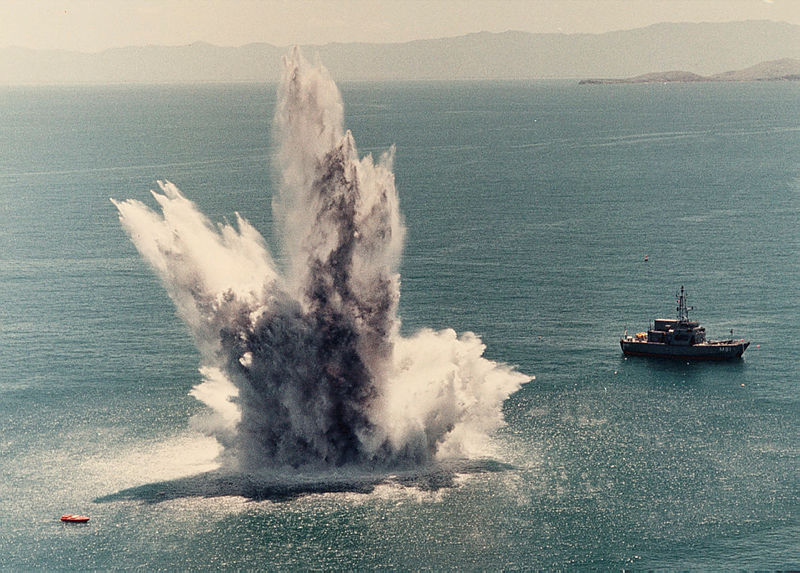
In mid-2018, the Chinese navy conducted one of the largest mine warfare exercises in living memory, involving some 60 minelayers and minesweepers, aircraft and submarines practising laying and countering live mines. This unprecedented exercise, supported by some of China’s top scientists and mine development specialists, increased the already growing unease about China’s expansion into the South China Sea.
Some 10 years ago, a US Naval War College study revealed that China possessed over 100,000 sea mines, and that their use was fundamental to its strategy of constraining US naval forces operating in Beijing’s area of interest. While, at the time, most strategists saw this as a direct reference to the Taiwan Strait and North Korea, that’s no longer so.
With China’s expansion into the South China Sea and its militarisation of several reefs far from its shores, its minelaying forces have a more expansive role to play. The People’s Liberation Army Navy has a fleet of ships and conventional submarines with crews that are well practised, and indeed lauded, for their minelaying skills. They also possess very capable minelaying aircraft. The exercise demonstrated China’s commitment to mine warfare as a pillar of its naval strategy.
Notwithstanding China’s potent capabilities in laying mines, many strategists wrongly believe they’ll be used in offensive operations, but they’re more versatile than that.
One possible scenario is that China will use its growing mine stocks in a period of tension to further control access to areas surrounding its South China Sea claims by laying protective minefields—or even just claiming to. International law allows for protective mining in a nation’s own waters, though an international court has ruled against part of China’s claim after it was challenged by the Philippines. By announcing the presence of such protective fields, it would provide the necessary warning to all comers. The answer, then, is for concerned nations to do something about the mines.
In 2018, Senator Jim Molan and the chair of the Parliamentary Joint Committee on Intelligence and Security, Andrew Hastie, drew attention to the parlous state of Australia’s fuel stocks with only three weeks’ supply in the country. All of Australia’s imported fuel passes through the Malacca Strait via Singapore and through other narrow passages through the Indonesian archipelago. We are particularly vulnerable to the closure of any of these vital seaways.
So how well prepared is Australia to counter a mining incident to our north, or near our priority ports or trade routes? After six Huon-class coastal minehunters were built in the late 1990s, two of the ships were laid up in 2014 due to defence cut backs. Both were so badly cannibalised that they have since been sold. The Royal Australian Navy once had a world-class minesweeping capability but it’s seldom used now.
It was recently announced that the four remaining Huon-class vessels will not have life-of-type extensions but will be retired within five years. A very modest program to introduce a minesweeping and mine-hunting capability is running years late and will provide an almost experimental-level capability of small individual technologies. The government announced last year that two steel-hulled ships, based on the offshore patrol vessel, will be built in Western Australia and designated for mine countermeasure operations to fill the gap left by the withdrawal of the Huons.
It appears that these ships will be built without any shock hardening, magnetic degaussing system or acoustic silencing and will carry some autonomous systems augmented by other systems yet to be announced. So, it would seem that the answer to the question ‘how prepared are we?’ is self-evident.
Close to two decades of underinvestment and neglect has once again rendered the navy’s mine-clearing force impotent. The last major strategic review, in 1991, was highly critical of the lack of attention to the mine threat and called for action. Out of that inquiry came the six coastal minehunters, a command support system, new sweeping systems, exercise mines and a completely rebuilt headquarters at HMAS Waterhen in Sydney.
Fast-forward to 2020 and we now face a much greater mine threat in our region than ever before, with most of our mine-hunting capability in decline—even though Australia remains totally dependent on sea-borne trade. A potential adversary to our north has the mine stocks, aircraft and submarines to completely shut down all sea traffic into our ports or sea lines of communication.
If our strategic situation turns bad, our maritime lifeline can easily be targeted, and we don’t have the means to stop that happening.

